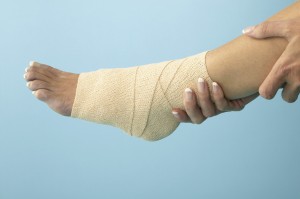Most injuries to the shoulder occur during athletic activities that involve repetitive, excessive overhead motion. These include pitching, weightlifting, tennis, and swimming. Some sports related shoulder injuries include shoulder instability, shoulder impingement, shoulder separation, shoulder dislocation, rotator cuff tears, acromioclavicular joint sprains, and SLAP lesions.
Shoulder Instability
When the shoulder joint is forced out of normal position, the condition is known as instability. Shoulder instability can result in a dislocation, which is quite painful. Most people who suffer with shoulder instability have pain when raising the arm and the shoulder feels as if it is slipping out of place. If this instability becomes a chronic, recurring problem, the surgeon may find it necessary to perform an arthroscopy. This procedure allows for the orthopedic specialist to look inside the shoulder with a tiny camera to assess the extent of the injury and perform surgery on the area to repair the soft tissues.
Shoulder Impingement
Impingement of the shoulder is caused by excessive rubbing of the tendons against the upper portion of the shoulder blade (the acromion). When there is repeated use of the arm overhead, shoulder impingement is likely. Injections and physiotherapy can improve this syndrome, but surgery is often necessary to remove bony spurs that trap the rotator cuff tendons and worsen the condition.
Shoulder Separation
With a separated shoulder, the acromioclavicular (AC) joint is injured. The AC joint is located where the collarbone (clavicle) meets the upper area of the shoulder blade (acromion). Most of these injuries are the result of a fall where the ligaments attaching to the underside of the clavicle become torn. A separated shoulder causes pain and deformity of the shoulder region. A mild separation involves AC ligament sprain and will appear normal on X-rays. With a more serious injury, the AC ligament could tear, putting the collarbone out of alignment. Â Most minor shoulder separations can be treated conservatively with the use of slings, cold packs, and medications for pain.
For more severe injuries, the orthopedic specialist may need to surgically trim back part of the end of the collarbone to prevent rubbing against the acromion. Also, the torn ligaments may need to be addressed by attaching them back to the underside of the collarbone to restore stability of the AC joint therefore allowing motion, flexibility, and strength to return.
Shoulder Dislocation
The shoulder joint is the most mobile joint of the body, making it potentially unstable and at risk for dislocation. Repeated dislocations result in instability and stretching of the shoulder joint, which can lead to poor sports performance and long periods out of the game. In order to reduce a shoulder dislocation, the surgeon will position the ball of the upper arm bone back into the joint socket by means of a closed reduction. For severely dislocated shoulders, however, surgery is often necessary to repair the torn or stretched tissues around the shoulder that normally support the joint.
Rotator Cuff Tears
The rotator cuff is a group of tendons and muscles that allow for movement and stability of the shoulder. The rotator cuff allows an individual to lift the arm and reach overhead. When this structure is injured, pain and weakness occurs. If tearing is significant, the surgeon may need to perform a rotator cuff repair through small incisions (arthroscopy) or by an open method.
Acromioclavicular Joint Sprain
The AC joint is important for athletes who throw and put their arms overhead. It is often sprained from repeated falls and can dislocate easily. When this joint is sprained, there will be pain and loss of normal movement of the shoulder. The orthopedic specialist can provide injections and physiotherapy to improve an AC sprain. Occasionally, with more significant AC sprains, an operation may be necessary to help alleviate persistent, long-term pain.
SLAP Lesions
Tears of the Superior Labral Antero-Posterior (SLAP) region of the shoulder occur with overhead throwing, tackling sports, and heavy lifting. Because the biceps anchors the shoulder, it is easily pulled off the bone by force. The symptoms of this type of injury include pain within the shoulder with lifting and sports. Many complain of a clicking sensation that extends down the upper arm. If the SLAP tears are not serious, the orthopedic specialist will prescribe non-steroidal anti-inflammatory medications and physical therapy. Some tears, however, will require surgical repair via arthroscopy or open techniques. This way, the surgeon can determine the extent of your injury and repair it at the same time.

